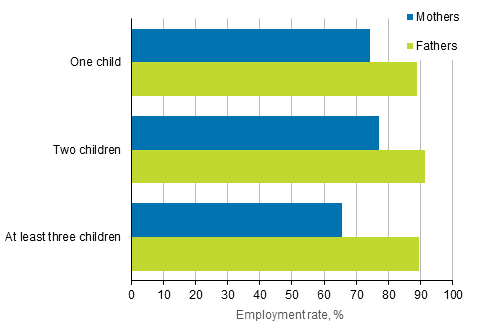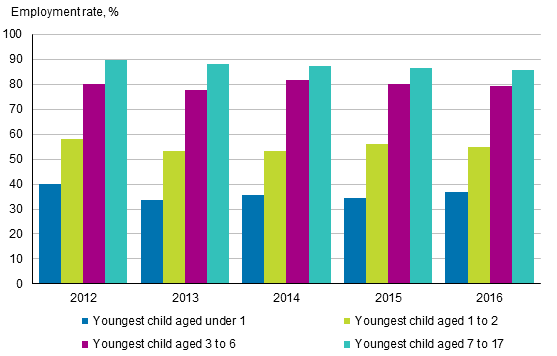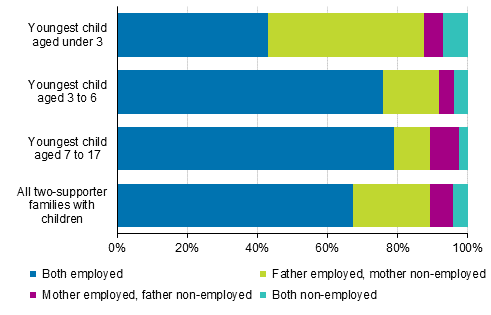3. Labour market position of parents in families with children
The number of children in the family affects the employment of mothers. The employment rate of fathers has for several consecutive years been around 90 per cent regardless of the number of children. On average, 76 per cent of mothers with one or two children were employed, while of mothers with at least three children 66 per cent were employed in 2016 (Figure 3). The employment rate of mothers with three or more children was in 2012 and 2016 the same, or 66 per cent. In turn, the employment of mothers with one child aged under 18 has fallen from 2012 to 2016. Seventy-eight per cent of mothers of one-child families were still employed in 2012, but only 74 per cent in 2016.
Figure 3. Employment rates for fathers and mothers aged 20 to 59 by number of children in 2016, %

The age of the youngest child in the family has an effect on mothers’ employment, especially when the child is small. However, mothers’ employment rate rises fast as the child grows (Figure 4, Appendix table 1). While 37 per cent of mothers of children aged under one were employed in 2016, this was so for as many as over one-half of mothers of children aged one to two and for 79 per cent of mothers of children aged three to six. Eighty-six per cent of mothers with school-age children were employed in 2016, though the share of employed has fallen from 2012, when their share was 90 per cent.
Figure 4. Employment rates for mothers aged 20 to 59 by age of their youngest child in 2012 to 2016, %

In families with underage children with two supporters, fathers usually have shorter family leaves than mothers. During paternity leave or child care leave of under three months, fathers are classified as employed so family leaves have little impact on the employment rate of fathers. Fathers’ employment rate is around 90 per cent regardless of the age of their children. Mothers’ employment rate is lower when children are small.
Both the father and mother were employed in 67 per cent of all two-supporter families with children in 2016. When the youngest child is between three and six years old, in 76 per cent of the two-parent families both parents are employed and this is so for 79 per cent of the parents of school-age children. (Figure 5.)
When the youngest child grows, the number of families with children where both parents are non-employed, that is, unemployed or in the inactive population, decreases. When the youngest child is aged under three, both parents were non-employed in seven per cent of two-supporter families. When the youngest child is of school-age, both parents were non-employed in only three per cent of families.
Figure 5. Labour market position of parents in families with children with two supporters aged 20 to 59 by age of youngest child in 2016, %

Source: Labour Force Survey 2016. Statistics Finland
Inquiries: Tarja Nieminen 029 551 3561, Anna P�rn�nen 029 551 3795, tyovoimatutkimus@stat.fi
Director in charge: Jari Tarkoma
Updated 10.10.2017
Official Statistics of Finland (OSF):
Labour force survey [e-publication].
ISSN=1798-7857. Families and work 2016,
3. Labour market position of parents in families with children
. Helsinki: Statistics Finland [referred: 29.12.2025].
Access method: http://stat.fi/til/tyti/2016/14/tyti_2016_14_2017-10-10_kat_003_en.html

